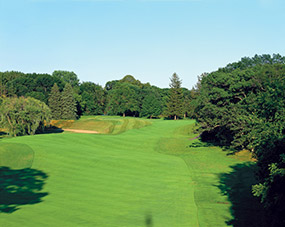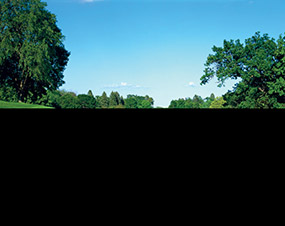One of American golf’s real charmers, the White Bear Yacht Club was formed as a sailing club for blue-blooded easterners on the banks of Minnesota’s pristine White Bear Lake back in the late 1800s. Golf was not added until 1912, but Donald Ross’s initial nine-hole course was such a hit that he extended the layout to eighteen holes in 1915. The sport then quickly became the club’s principal recreational activity.
Low-profile and continuing to sneak under the radar of ranking panels, the course Ross designed here was one of his very best, and certainly the most interesting for golfers conditioned to believe that great terrain, rather than great turf, is the essential ingredient for great golf. Like at nearby Interlachen, Ross brilliantly incorporated all of the natural features of the site into a routing that moves across a series of radically undulating hills and ridges. With the exception of the 18th fairway, there is no let up from the natural bump and flow of the land so for those who don’t appreciate odd bounces, side-hill stances and hitting into obscured targets the par threes will offer your only relief.
White Bear starts with a tremendous par four that first plunges downhill and then rises up into an elevated green set beyond a huge bunkered ridge. The 2nd and falling par three 3rd are also good, but it’s the prolonged stretch of quality holes from the 5th to the 17th which really elevates the track into America’s elite. Massive undulations and cool greens make the 5th, 10th, 12th and 15th exciting par fours to play while the 7th is a classic par five with genuine three-shot options and an aggressive, but dangerous, two-shot strategy. Narrow and bumpy from the tee, its green is within reach but set on a spur and protected by a hump that kicks most balls away to tricky chipping gullies. This hole, as well as other wild five’s like the 9th, 13th and 16th, underscore the quality of Ross’s routing and his ability to locate fun and interesting green sites. Generally small but with lots of natural shape, the targets here show tremendous imagination and are full of subtle variety. Both the 11th and 12th, for instance, are situated beyond a frontal crest, the 11th with a high backdrop to allow balls to feed toward the pin and the 12th, by contrast, falling away steeply at the rear. There are at least seven or eight other outstanding greens, as well as a number of approach shots that rank among the most enjoyable Ross ever conceived.
Interestingly, his original plans for White Bear were destroyed during the 1930s and the course suffered through an extended period of neglect thereafter. Thankfully this neglect was addressed by the careful restoration work of Tom Doak’s team during the 1990s. Reinstating fairway widths and green areas, they also removed inappropriately planted trees and unnecessary traps, including those near the 7th and 9th greens, which in turn allowed full restoration of some fascinating chipping areas. This project was an enormous success and has helped present-day members better appreciate the true quality of their precious layout.
Donald Ross designed some remarkable courses in America, but few that have managed to evade publicity as successfully as the White Bear Yacht Club. With some of the finest slopes for golf in the Midwest, there is no doubt that were the layout a little longer and the climate more conducive to growing decent golf grasses, passionate golfers from all over the world would flock to play here.

 this course also has exceptional:
this course also has exceptional:

